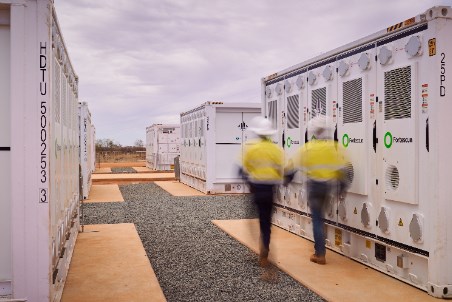Smart Home Energy Savings: Real-Time Pricing and Hybrid Systems for Optimized Grid Consumption – renewableenergymagazine.com

Advancing Sustainable Development Goals Through Smart Energy Systems
Real-Time Pricing (RTP) as a Catalyst for Sustainable Energy Consumption
Real-Time Pricing (RTP) is an electricity pricing model where rates vary based on the real-time cost of power generation and delivery. This system directly supports several Sustainable Development Goals (SDGs) by creating a more efficient and responsive energy grid.
- SDG 7 (Affordable and Clean Energy): RTP promotes the use of electricity during off-peak hours when renewable energy sources are often more abundant and less expensive, making clean energy more affordable.
- SDG 12 (Responsible Consumption and Production): By financially incentivizing consumers to shift their energy use away from peak demand periods, RTP encourages more mindful and sustainable consumption patterns.
- SDG 9 (Industry, Innovation, and Infrastructure): The implementation of RTP necessitates the adoption of smart grid infrastructure, such as smart electric meters, which are crucial for building resilient and modern energy systems.
- SDG 13 (Climate Action): Shifting demand to periods of high renewable generation reduces the need for carbon-intensive peaking power plants, thereby lowering overall greenhouse gas emissions.
The core mechanism involves balancing supply and demand costs, which can lead to reduced generation costs and smoother demand curves. This enhances grid stability and supports the large-scale integration of variable renewable energy sources.
Hybrid Energy Systems: A Framework for Clean and Resilient Power
Hybrid energy systems, which combine multiple power sources, offer a robust solution for advancing global energy goals. These systems are designed to provide a consistent and reliable power supply, primarily from renewable sources, directly contributing to SDG 7 and SDG 11 (Sustainable Cities and Communities).
- Solar Power: Leveraging advanced photovoltaic technology, such as bifacial panels and Maximum Power Point Tracking (MPPT) controllers, maximizes the generation of clean energy. This innovation (SDG 9) is fundamental to increasing the share of renewable energy in the global mix (SDG 7).
- Wind Power: Utilizing both Horizontal Axis Wind Turbines (HAWTs) and Vertical Axis Wind Turbines (VAWTs), these systems convert kinetic energy into electricity. Optimizing turbine selection and placement based on site-specific conditions ensures efficient energy capture, supporting the clean energy transition (SDG 7).
- Energy Storage: To address the intermittency of renewables, hybrid systems incorporate storage solutions like Hybrid Energy Storage Systems (HESS) and advanced Battery Management Systems (BMS). This critical infrastructure (SDG 9) ensures a reliable and uninterrupted supply of clean energy, enhancing community resilience (SDG 11).
- Backup Power: The integration of clean backup technologies, such as hydrogen fuel cell generators, provides zero-emission reliability. This displaces traditional fossil-fuel generators, directly supporting climate action initiatives (SDG 13) and promoting sustainable energy security (SDG 7).
Synergistic Benefits for Global Sustainability Targets
Contributions to Key Sustainable Development Goals
The combined implementation of RTP and hybrid energy systems creates a powerful synergy that accelerates progress toward a sustainable future. Their benefits align directly with the targets of several SDGs.
- Improved Reliability and Resilience (SDG 7, SDG 11): By diversifying energy sources and incorporating storage, hybrid systems ensure a consistent power supply. Advanced microgrid controllers enhance stability, making energy infrastructure more resilient to disruptions, a key target for sustainable communities.
- Environmental Sustainability and Climate Action (SDG 13, SDG 7): These systems significantly reduce reliance on nonrenewable sources, cutting greenhouse gas emissions. Life Cycle Assessments (LCA) confirm their net positive environmental impact over their operational lifetime, contributing directly to climate change mitigation.
- Grid Independence and Energy Access (SDG 7, SDG 11): Hybrid systems are essential for providing reliable power to remote and off-grid communities, as demonstrated by projects for First Nations communities in Australia and the Taishan Antarctic research station. This capability is crucial for ensuring universal access to modern energy.
- Cost Efficiency and Economic Viability (SDG 7): The declining Levelized Cost of Energy (LCOE) for renewable and hybrid systems makes clean energy an economically competitive choice. This affordability is key to achieving the goal of affordable energy for all.
- Scalability and Technological Innovation (SDG 9): The modular architecture of hybrid systems, supported by interoperability standards like IEEE 1547, allows for scalable deployment from individual homes to large businesses. This fosters innovation and facilitates the development of sustainable and resilient infrastructure.
Conclusion: Integrating Smart Technologies for a Sustainable Energy Future
Smart energy management, through the adoption of Real-Time Pricing and hybrid energy systems, is fundamental to building a resilient and sustainable global energy infrastructure. These integrated solutions provide a clear pathway toward achieving the Sustainable Development Goals by creating power grids that are cleaner, more affordable, and more equitable for both people and the planet.
Analysis of Sustainable Development Goals in the Article
1. Which SDGs are addressed or connected to the issues highlighted in the article?
-
SDG 7: Affordable and Clean Energy
The article’s primary focus is on making energy more affordable, reliable, and clean. It discusses Real-Time Pricing (RTP) to manage costs and consumption, and extensively details hybrid energy systems that utilize renewable sources like solar and wind, directly aligning with the goal of ensuring access to modern and sustainable energy for all.
-
SDG 9: Industry, Innovation, and Infrastructure
The text highlights the need for advanced infrastructure, such as smart meters for RTP and modern microgrids. It discusses innovations in energy technology, including bifacial solar panels, advanced wind turbines (HAWTs and VAWTs), Hybrid Energy Storage Systems (HESS), and the importance of industry standards like IEEE 1547 for creating resilient and scalable energy infrastructure.
-
SDG 11: Sustainable Cities and Communities
By promoting grid independence and stability, especially for remote areas like the First Nations communities in Australia, the article addresses the need for resilient and sustainable community infrastructure. These systems make communities less reliant on centralized grids, enhancing their energy security and sustainability.
-
SDG 12: Responsible Consumption and Production
RTP is presented as a mechanism to encourage more “mindful household power consumption.” By linking cost to real-time demand, it incentivizes consumers to shift their energy use to off-peak hours when renewable energy is more available, promoting more sustainable consumption patterns.
-
SDG 13: Climate Action
The article explicitly states that switching to hybrid renewable energy systems helps “reduce greenhouse gas emissions and prevent further environmental damage.” It provides a concrete example of the Noor Ouarzazate Solar Complex minimizing carbon emissions, directly contributing to climate change mitigation efforts.
2. What specific targets under those SDGs can be identified based on the article’s content?
-
SDG 7: Affordable and Clean Energy
- Target 7.2: By 2030, increase substantially the share of renewable energy in the global energy mix. The entire discussion on hybrid systems combining solar and wind power is aimed at increasing the use of renewable energy.
- Target 7.3: By 2030, double the global rate of improvement in energy efficiency. RTP encourages “load shifting” and more conscious energy use, which improves demand-side efficiency. Technological advancements like bifacial solar panels that increase “energy yields by up to 27%” and high-efficiency HAWTs contribute to supply-side efficiency.
- Target 7.a: By 2030, enhance international cooperation to facilitate access to clean energy research and technology… and promote investment in energy infrastructure and clean energy technology. The article details numerous advanced technologies (HESS, fuel cells, MPPT controllers) and notes that some companies “lack the infrastructure to support” modern systems, highlighting the need for investment.
-
SDG 9: Industry, Innovation, and Infrastructure
- Target 9.1: Develop quality, reliable, sustainable and resilient infrastructure… with a focus on affordable and equitable access for all. The article emphasizes how hybrid systems improve reliability and stability, and their application in remote communities (like First Nations in Australia and the Taishan Antarctic station) demonstrates building resilient infrastructure for equitable access.
- Target 9.4: By 2030, upgrade infrastructure and retrofit industries to make them sustainable, with increased resource-use efficiency and greater adoption of clean and environmentally sound technologies. The promotion of smart meters, microgrids, and the switch from fossil fuels to renewable hybrid systems directly supports this target.
-
SDG 11: Sustainable Cities and Communities
- Target 11.6: By 2030, reduce the adverse per capita environmental impact of cities, including by paying special attention to air quality and municipal and other waste management. The article’s focus on reducing greenhouse gas emissions through renewable energy contributes directly to lowering the environmental impact of the energy consumed by communities.
-
SDG 12: Responsible Consumption and Production
- Target 12.2: By 2030, achieve the sustainable management and efficient use of natural resources. The shift from finite fossil fuels to renewable resources like solar and wind, as detailed in the section on hybrid systems, is a core element of this target.
-
SDG 13: Climate Action
- Target 13.2: Integrate climate change measures into national policies, strategies and planning. The adoption of systems like RTP and the promotion of hybrid energy systems are concrete strategies that can be integrated into energy policies to mitigate climate change.
3. Are there any indicators mentioned or implied in the article that can be used to measure progress towards the identified targets?
-
For SDG 7 (Affordable and Clean Energy)
- Indicator 7.2.1 (Renewable energy share): The article provides a specific data point for this indicator with the example of “China’s Taishan Antarctic research station,” which “achieves over 80% renewable energy utilization annually.”
- Indicator 7.3.1 (Energy efficiency): Progress can be measured by the specific technological improvements mentioned, such as bifacial solar panels increasing “energy yields by up to 27%” and the efficiency difference of “approximately 25% in favor of HAWTs” over VAWTs.
-
For SDG 9 (Industry, Innovation, and Infrastructure)
- Indicator 9.4.1 (CO2 emission per unit of value added): The article provides a direct measure of emissions reduction: “The Noor Ouarzazate Solar Complex in Morocco… minimizes carbon emissions by around 230,000 tons annually.”
-
For SDG 13 (Climate Action)
- Indicator 13.2.2 (Total greenhouse gas emissions): The reduction of “230,000 tons” of carbon emissions annually by the Noor Ouarzazate Solar Complex serves as a direct measurement for this indicator, quantifying the impact of renewable energy projects on climate action.
4. Summary Table of SDGs, Targets, and Indicators
| SDGs | Targets | Indicators Identified in the Article |
|---|---|---|
| SDG 7: Affordable and Clean Energy |
7.2: Increase the share of renewable energy.
7.3: Double the rate of improvement in energy efficiency. |
– The achievement of “over 80% renewable energy utilization annually” at the Taishan Antarctic research station. – Increased “energy yields by up to 27%” from bifacial solar panels. – HAWTs achieving power coefficients “between 0.35-0.45” compared to “0.15-0.30 for most VAWT designs.” |
| SDG 9: Industry, Innovation, and Infrastructure |
9.1: Develop quality, reliable, sustainable and resilient infrastructure.
9.4: Upgrade infrastructure and adopt clean technologies. |
– The implementation of hybrid microgrids in remote communities (First Nations in Australia, Taishan station) to ensure reliable power. – The reduction of carbon emissions as a measure of clean technology adoption. |
| SDG 11: Sustainable Cities and Communities | 11.6: Reduce the adverse per capita environmental impact of cities. | – The reduction of greenhouse gas emissions through renewable energy systems, which lowers the overall environmental footprint of energy consumption in communities. |
| SDG 12: Responsible Consumption and Production | 12.2: Achieve the sustainable management and efficient use of natural resources. | – The shift from fossil fuels to renewable sources (solar, wind) is an implied indicator of progress toward sustainable resource management. |
| SDG 13: Climate Action | 13.2: Integrate climate change measures into policies and planning. | – The specific quantification of “minimizes carbon emissions by around 230,000 tons annually” by the Noor Ouarzazate Solar Complex. |
Source: renewableenergymagazine.com

What is Your Reaction?
 Like
0
Like
0
 Dislike
0
Dislike
0
 Love
0
Love
0
 Funny
0
Funny
0
 Angry
0
Angry
0
 Sad
0
Sad
0
 Wow
0
Wow
0



















































.jpg.webp?itok=0ZsAnae9#)


























